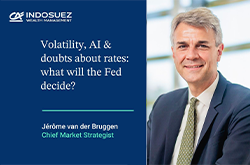From the fear of inflation to the fear of a slowdown

Monthly House View - December 2021 - Download here
As we approach the end of the year, with investors asking questions about the investment outlook for 2022, it’s worth taking a look back at the principal risks surrounding the growth scenario. In this highly unusual recovery phase, characterised by severe imbalances, the forecasting risk remains high. This could be amplified by a effervescence in the field of economic forecasting, which has become more reliant on high-frequency activity indicators since the pandemic.
The first risk of uncertainty concerns US growth trend, for which the regional central banks’ forecasting models are giving mixed signals. Among the least optimistic indicators is the New York Fed’s model, which predicts growth at 1.7% for the fourth quarter of 2022; this would imply a significant slowdown compared with the trend anticipated for the fourth quarter of 2021. Looking at the forecasts from major international institutions, differences in forecasts are greater for the United States than for Europe, with the OECD forecasting 3.9% growth in the United States in 2022, compared with 5.2% according to the IMF. Multiple factors are at play in this deceleration, including the disappearance of base effects, bottlenecks, supply chains issues, and the reduction of the Biden plan. Although the economic debate is now focused on inflation, the growth trend will be a key issue for monetary policy decisions next year.
The second macroeconomic risk relates to the speed of landing in the Chinese property sector and macroeconomic management. Faced with a bloated property sector that could have a significant impact on Chinese growth, we might have expected a stronger economic response from the Chinese authorities, who could have sought to counterbalance the restructuring of the sector with monetary and fiscal support for the rest of the economy. For the moment, the authorities are showing a degree of cautiousness that is at odds with the strength of the response seen in 2009 and 2015. With the IMF and OECD forecasting growth of between 5.6% and 5.8% in 2022, the idea that Chinese real estate could cost the Chinese economy one to two points of growth could be retained.
The third risk concerns the resurgence of the pandemic in Europe, with responses that could diverge even further between the countries, reflecting not only different healthcare strategies but also specific political contexts, that could delay the return to remote working that is already emerging in Germany. Faced with this trend towards a resurgence of the pandemic, the growth figure of 4% to 4.5% forecast for 2022 could also be revised downwards.
The final hazard is global and relates to supply chain problems, the effects of which could continue well into 2022. In the third quarter, this factor probably cost one to two points of growth, as evidenced by the disappointing US growth in the third quarter (2%) or industrial production in China, which remained subdued in September compared with the previous month. There is no doubt that these issues should eventually be resolved, but it is difficult to predict how long this will take, and scenarios for 2022 only partially integrate this.
If we add all these risks together, we could see a shift from a scenario of global growth well above 4% to a scenario in which it is barely above the 3% threshold that is considered by investors as the point below which it is generally advisable to reduce investments in risky assets.
This is not our scenario today, but after increasing the probability of reflationary acceleration, we should take into account the risk of disappointment over growth.
The other key implication concerns the central banks. In the face of strong growth and inflation above target, the normalisation of the Fed’s interest rates would not usually be in question.
However, with inflation remaining high and a growth rate that could be disappointing, a dilemma is emerging. Perhaps this explains Jerome Powell’s cautious approach, as his future at the Fed hangs in the balance.
Monthly House View, 22/11/2021 release - Excerpt of the Editorial
November 30, 2021




